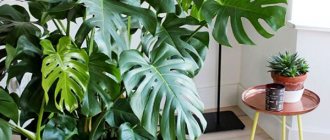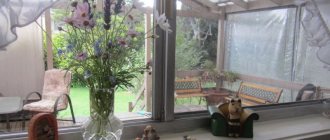You can only grow one type of coffee at home: Arabian. A plant of this species has wavy, smooth oval leaves with a sharp tip.
For a young tree you need to choose the right permanent location. The plant does not like unnecessary movements - even a slight change in its position in space will cause the leaves of the coffee tree to fall off.
The coffee tree needs a very bright place, but not direct sunlight. In partial shade, the plant will hurt and look pitiful. Irrigation and water quality are important. This plant does not like drying out or waterlogging the earthen clod. The soil must be selected very carefully: use peat or coconut substrate and regularly feed it with fertilizer that does not contain calcium salts. Leaves can dry out from lack of light and humidity, as well as from drafts. For good care, the coffee tree will thank you with real Arabian coffee beans!
Calculate the exact cost of repairs using an online calculator
and receive a free detailed estimate for repairs
Calculate Photo: sovetnews.com
Types of indoor trees and breeding conditions
Large plants in tubs perfectly decorate the interior. With proper watering, they provide lush greenery all year round. Of the existing species diversity, preference is often given to some variety that is undemanding in care. We’ll tell you in more detail about which specimens can be bred at home.
With constant employment, spending free time on hobbies and hobbies is an unaffordable luxury. Unpretentious varieties that do not require special conditions for growth and flowering are popular among apartment and house owners. The following varieties are common:
- citrus fruits (lemon, tangerine, orange, kumquat);
- exotic (breadfruit, bamboo, shefflera);
- ficuses (Benjamina, Bengal, rubber);
- palm trees (date, banana, rapis);
- bonsai (pine, spruce, sakura);
- flowering (hibiscus, abutilon).
The owners decide for themselves which species to give preference to. When making a choice, you should take into account the nuances. You need to determine in advance where the flower pot will be located. For the plant to be healthy, there must be enough lighting in the house. You should choose a flower carefully if there are small children and animals in the house. Some of the plants contain harmful substances that are hazardous to health.
Ficus
There are more than 20 species of domestic trees of the ficus genus. They vary in shape and appearance. An unpretentious plant does not require frequent watering and feeding. It cleans the air well, neutralizing benzene, formaldehyde and other harmful substances. Some ficus trees are poisonous. They should not be kept in a home where there are children and pets.
Ficus rubber produces volatile substances that are harmful to asthmatics. It is not recommended to place it in the bedroom and nursery.
Ficuses with large, juicy greens forming a dense crown look beautiful in the interior. The following varieties of ficus are optimal for home interiors:
- Ficus Benjamin;
- rubbery;
- lyre-shaped;
- Ficus Binnendieck;
- ampelous;
- Bengal;
- dwarf;
- bottle.
Ficus is one of the most common indoor plants. It can often be found in apartments and offices. To make the flower look healthy, it is enough to water it abundantly from time to time.
The most popular living trees growing at home or in an apartment in a pot
Indoor living trees, unlike other indoor flowers, have a central trunk and branches . Some of them bloom at home, in other cases the tree has a lush crown. Thanks to pruning, they can be shaped. The most popular is to create Bonsai from them. Indoor pets perform a decorative function and, in addition, freshen the air .
They are used for landscaping apartments, offices and commercial premises. Large, beautifully flowering, and deciduous trees can come in a variety of shapes. They also differ in the shape and color of the leaves. Features of the most popular species that grow in flower pots will allow you to turn your room into a blooming garden.
A coffee tree
A unique plant of its kind with beautiful foliage. At home, it blooms and pleases all year round with its greenery. In place of the inflorescences, berries are later formed. The leaves appear dense, shiny and textured.
A coffee tree
With proper care, its height can reach 1 meter . The crown is formed by pinching. It tolerates drought well; it is recommended to wipe the leaves with a damp cloth.
Monstera is a common indoor flower in apartments. An adult tree is quite tall and spreading . The leaves are large, with symmetrical slits. The color of the leaves is bright green and shiny. The monstera leaf is dark green in color and shiny. Over time, aerial roots form in the lower part. There is no need to remove them; they provide the plant with support and additional nutrition. Blooms rarely, with white inflorescences.
Monstera is suitable for large spaces. The height can reach 3-5 meters .
The spread of the indoor tree in a flat pot originated in China, later in the West and Japan. The creation of Bonsai has become a whole science. A miniature copy of a tree with a powerful crown has its own characteristics.
- Bonsai is considered to be an indoor plant with a strong trunk and a well-developed root system ;
- the branches must have a clear outline, they can have a curved shape;
- the trunk should not be hidden in the foliage; its ratio is kept to a minimum;
- The pot used is flat, often clay, and discreetly colored.
Florists will classify bonsai by size and shape. Care requires some knowledge of the characteristics of this variety.
An exotic houseplant is not only beautiful, but also useful. With proper care, it bears fruit all year round . There are many varieties, they differ in tree height, leaf shape and fruit.
Productivity lasts up to 20 years . The leaves are bright green and dense. They are used for brewing tea. Thanks to its unique properties, lemon helps purify the air.
He is afraid of drafts, if he is comfortable in one place, there is no need to move him again.
Lemon Tree
Chinese rose
A beautifully blooming rose can grow to gigantic sizes . The trunk is tree-like; the older the flower, the stronger the crown grows. The shape can be adjusted by trimming. It blooms with large scarlet inflorescences. Scientifically called hibiscus.
Suitable for indoor and greenhouse cultivation. Propagated by seeds, dividing the bush, layering and cuttings. Easy to care for, it will decorate any room with its presence.
The evergreen tree can be found in warm Asian countries. We grow it at home. The leaves are dense, oval in shape. The leaf color is green or bicolor.
It rarely blooms with unsightly-looking inflorescences. Florists use different types of ficus to create bonsai. The height of an adult flower can be 3-5 meters. Propagated by cuttings. It is recommended to apply fertilizer 2-3 times a month. If not properly cared for, the leaves may fall off completely.
In ancient times, laurel was considered sacred. Today, Europeans use the evergreen plant in landscape designs. A noble tree with fragrant leaves, it is often grown in kitchens for use as a seasoning .
- leaves are dense, dark green;
- the bush grows slowly, is not afraid of pruning;
- laurel loves bright and spacious rooms;
- After flowering, seeds form in place of the inflorescences.
An unpretentious indoor flower will not cause much trouble; it will become a worthy interior decoration. In the summer, pots with laurel can be taken out onto the balcony or loggia.
Laurel
Tangerine
A sunny and elegant tangerine tree will become a bright element of landscape design of premises. The plant releases special substances that enrich the air .
Mandarin repels insects and produces good yields of fragrant fruits. You can often find dwarf varieties of mandarin on windows. The leaves are dense and green. The trunk is tree-like. It blooms with small flowers, in place of which green tangerines are formed. When ripe, the fruits turn orange.
Read also: Clematis in Siberia: choosing a variety, planting and caring for the plant
Bottled
The tree, whose trunk is shaped like a bottle, can be found in nature in Mexico and the USA. Scientific name: nolina, bocarnea. The leaves are palm-shaped, thin with pointed edges. Grow in small pots.
The plant loves the sun, is not afraid of drought, but still requires regular spraying. 6-8 years to get a large trunk . If you water abundantly, the trunk will rapidly stretch upward, so you need to organize drought conditions.
bottle tree
A real miracle, rarely does anyone manage to grow it correctly and enjoy flowering. The flowering period occurs after 5-6 years . Until this moment, the plant resembles a snake. Later it rushes upward and forms a tree. The buds look mesmerizingly beautiful, but at the same time they emit a sickening smell . Those who decide to place it in a residential area must take this fact into account.
When growing compact trees at home, do not forget that this is painstaking work. It will take several years to get an original bonsai. You can buy a ready-made tree or get cuttings from friends. There are no particular difficulties in care, you just need to take into account their features.
Dieffenbachia
It grows up to two meters in height. The motley guest from the sunny tropics is demanding in care. She cannot stand drafts and cold. Uneven watering leads to yellowing of the leaves. In order for the leaf to retain its rich green color, it is necessary to spray with warm water.
Dieffenbachia can liven up a boring apartment interior. But not everyone knows that its juice is poisonous. When it comes into contact with human skin, irritation occurs. If the juice splashes into the eyes, vision problems may occur. In a family where there are small children and animals, Dieffenbachia should not be bred.
Variety of species
Plants in the house will help not only purify and humidify the air, but also make the interior more interesting. That is why they are reliably replacing artificial decorative trees for the home. Currently, the variety of living indoor trees is very large. They are popular and are found in almost every home.
The variety of species allows you to choose plants that require care for experienced people and are completely unpretentious, which almost anyone can grow. In most cases, it is enough to know a few simple tips for caring for a plant.
Trees for your home can vary in height and size. Some are dwarf and suitable for growing on a window or table. Others reach a height of a couple of meters. They are placed directly on the floor.
Read also: Gasteria: description of a houseplant, care at home
Boxwood
The evergreen beauty grows up to 12 m in height. Garden boxwood can be grown in an apartment. Dense greenery, forming a dense crown, will decorate the design in an oriental style. Do not forget that boxwood is considered a long-liver. With proper care, it will delight its owners for many years.
The planted sprout grows slowly, up to 5 cm per year. Around the columnar trunk, many shoots are formed, covered with small glossy leaves.
There are more than 50 varieties of boxwood. The following varieties are suitable for growing at home:
- evergreen;
- small-leaved;
- Balearic.
The evergreen beauty requires circular pruning. Boxwood branches grow quickly. Regular pruning gives the plant a well-groomed appearance. A compact boxwood figure will be a wonderful decoration for an apartment or office. This decorative beauty perfectly purifies the air. It should be remembered that its stems and leaves are poisonous. It is not recommended to place boxwood in a nursery. Greens are also dangerous for pets.
Laurel
In an apartment, laurel can grow even with a lack of lighting; it is not afraid of drought and drafts. It is easy to care for. With moderate watering, the laurel will delight with greenery all year round. The fragrant leaves can be used as a seasoning in cooking.
Homemade laurel is not afraid of diseases and pests. In a cozy environment, the giant grows up to 15 meters. Curly pruning will help limit excessive growth. At home, laurel lives 12-15 years. In order for the bush to form a lush crown, it is trimmed starting from the age of five. The following varieties of decorative laurel are distinguished:
- noble;
- Canarian.
Noble laurel exudes a pleasant tart aroma. But the Canarian has beautiful wide leaves. Botanical varieties look great in urban interiors.
Hovea
Howea perennial belongs to the palm family. Under artificial conditions, the trunk, covered with ring-shaped scars, grows to the ceiling. The feathery leaves form a shady canopy. Khoveya is withering away from lack of light. It should be located in a spacious room, closer to the windows facing south. Watering should be moderate in winter and abundant in summer.
Palm trees do not tolerate dry air well. From lack of moisture, its leaves begin to turn yellow. From time to time, the greens need to be sprayed with water at room temperature. It is important not to allow the lump of earth in the pot to dry out. To prevent this from happening, in the event of a long absence, an automatic watering system is necessary.
The perennial palm grows to gigantic size, spreading its feathery leaves widely. It should be located in spacious rooms. Green beauty cleans the air well. Its leaves are safe for animals and small children. Khoveya can be placed in a spacious nursery.
Beautiful flowering trees and shrubs
These trees attract not only the shape of the crown and the beauty of the leaves, but also their abundant flowering. They are planted as individual accent elements (solitaires) or included in group compositions. Dwarf species are suitable for patios and courtyards.
Sakura
Sakura (cherry serrata) belongs to the Rosaceae family. In the Russian climate, varieties bred on the island of Hokkaido are grown:
- Shirofugen - sakura grows up to 10 m, it has a spreading crown, soft pink flowers bloom in spring, the color of the foliage depends on the time of year (crimson in spring, green in summer, orange-red in autumn);
- Royal Burgundy - height is 6 m, the shape of the crown at the initial stage resembles a funnel, but smoothes out over time;
- Fukuband - the tree grows to a maximum of 2 m, the crown is dense, the flowering is abundant.
Seedlings are planted on a southwestern slope; neutral soil reaction is preferable. Sakura grows well in loam. The thickness of the drainage layer in the planting hole is 10 cm. After planting, a ditch is dug around the tree and filled with water.
Almond
Almonds are considered one of the most beautiful trees for the garden. Of the almost 40 types of almonds in Russia, only the steppe variety (bean, almond) can be grown. The plant is very decorative. It reaches a height of 1.5 m. Its crown is spherical or ovoid. The leaves of the bean plant are dense, leathery, and dark green. Flowering occurs in May, it is very abundant - pink flowers literally envelop the tree. The best varieties:
- Pink mist;
- Dream;
- Anyuta;
- Pink flamingo.
Plants are planted in spring. A 10 cm hole is filled with drainage and covered with nutritious soil. When filling the hole, the root collar is not buried; the seedling is tied up and watered.
Related article:
Plum does not bear fruit: what to do?
Dracaena
Tropical dracaena is called the dragon tree: “dracaena” means dragon in Latin. An adult plant looks like a palm tree. The leafless stem ends in a tuft of long leaves bent downwards. Dracaena belongs to the asparagus family. In nature there are up to 40 plant species. The following varieties are common in home floriculture:
- fragrant;
- bordered;
- Derema;
- Sandera;
- godsefa;
- bent.
Dracaena is extremely popular among gardeners. At home, with proper care, it lives 12-15 years. Looking after her is not much of a hassle. A newly purchased dracaena needs to be transplanted from a cramped pot. As the root system grows, replanting must be repeated.
Dracaena loves diffused sunlight, like in the tropics. It should be placed near a south window, shaded by light curtains. The southern beauty cannot stand cold and drafts. In unfavorable conditions, the leaves begin to turn yellow and fall off.
Crassula
The money tree is common in home floriculture. The name comes from the fact that its leaves look like coins. They have a round shape, which is due to their ability to accumulate moisture and nutrients. Indoor succulent grows up to 2 meters in height. Crassula propagates by cuttings.
It needs to be replanted once every two years. A weak root system is not able to support the weight of an adult plant. A deep pot with thick walls is suitable for replanting, which will not allow the fat plant to fall.
The tree needs regular watering: the water should be settled and warm. Crassula is a shade-tolerant plant. With a lack of lighting, it changes shape. Its stems stretch out and become thin. Direct sunlight is contraindicated for her. This causes the greenery to wither and begin to fall off.
Abutilone
The plant of the mallow family grows up to 1.5 meters in height at home. The thick stem is crowned with a lush crown. It is covered with curly leaves, similar to maple leaves. Because of the shape of the leaves, abutilon is called indoor maple.
Tropical abutilon loves heat and humidity and does not tolerate lack of lighting. With good supervision, indoor maple grows and branches quickly. In spring, its branches are covered with bright flowers - bells of pink, purple, red or golden color. Flowering continues until late autumn. More than 100 varieties of indoor maple are known. The following types are common in home floriculture:
- Bella;
- Juliet;
- Organza;
- Bellevue;
- Bella mix;
- Sello;
- Eye of the Tiger.
The above varieties are distinguished by beautiful flowering. Every spring the green crown is covered with lush flowers. The abutilon flower is extremely beautiful. The calyx of a large flower is crowned with bright petals covered with delicate reddish veins (can be seen in the photo). During the flowering period, abutilon needs abundant watering and weekly feeding.
How to grow dwarf pomegranate at home
Despite the fact that this tree can easily decorate absolutely any interior, few people dare to grow pomegranates at home. However, it is a beautiful tree with a long flowering period from April to September. Its flowers can be red, white, yellow or pink - it depends on the variety.
For growing pomegranate at home, only those seeds that can be collected from its flower are suitable. Unfortunately, pomegranate seeds are not suitable for this purpose. Therefore, in this case, planting material will have to be purchased.
Purchased seeds are pre-soaked for 24 hours in a solution of Kornevin or another growth stimulant. Then they are planted in loose soil to a depth of 0.5 cm, watered and the container is covered with glass. Sprouts should appear in less than a month. After the seeds germinate, they need to be transplanted into small containers that provide drainage.
The best soil for dwarf pomegranate is rose or begonia soil.
Pomegranates need a lot of light. If there is not enough light, the tree will shed its leaves in protest. Comfortable temperature for pomegranate is 25°C. In order to provide the plant with a winter dormant period, it is kept at a temperature of 10°C for a month. Water the pomegranate once a week. As a rule, you need to water when you notice that the top layer of soil is crumbling under your fingers. To spray pomegranate, use only warm water.
For good growth and flowering, pomegranates are fed from autumn to spring. To do this, use a solution of mullein (first prepare an infusion in the proportion of 1 kg per 10 liters of water, which is kept for 5-7 days, and then diluted with water 1:3 and used for irrigation). An infusion of chicken manure is very useful for indoor pomegranate. It is prepared like this: the droppings are poured with water in a ratio of 1:2, the container is tightly closed and left in a warm place for fermentation. After 2-3 weeks, open and dilute the infusion with water 1:25. The finished fertilizer is applied immediately after watering.
Flower growers recommend replanting pomegranates once every 3-5 years. For the substrate you will need 2 parts of turf soil, 1 part of leaf humus, half of peat and half of sand. Sometimes sand, loam and peat are mixed - 2:1:1, respectively. For pomegranate, a substrate of 2 parts clay-turf soil with the addition of leaf soil, humus and sand in equal quantities is also suitable.
If you did everything correctly, then in five years the tree will delight you with its first harvest. For particularly successful gardeners, pomegranate begins to bear fruit after three years of growth.
Hibiscus
The Chinese rose fits perfectly into the interior of an apartment or office. With proper care, it grows up to 1.5-2 m in height. Chinese hibiscus is a long-lived plant. Under favorable conditions, it lives for several decades. Large green branches forming the crown are its decoration. If you properly care for a Chinese rose, it will thank its owner with beautiful blooms. Hibiscus flowers are bright, large, with large petals. The Chinese rose is unpretentious in care. For full growth, regular watering and spraying is sufficient. Hibiscus can grow in artificial light, in rooms completely devoid of natural light.
Dwarf trees
Living ornamental trees for the home that are short in height are called dwarf trees. They are divided into two types:
- Bred through selective breeding.
- Bonsai (these are ordinary trees whose height has been artificially reduced).
The first group is the most popular. As for the second, it’s not so simple. Their number is small, which is due to the complexity of their cultivation. Bonsai can grow up to several hundred years and still remain miniature. Some examples are even shown at exhibitions and cost several thousand dollars. As a rule, they are raised in a separate family and passed on by inheritance.
These small ornamental trees for the home are difficult to care for and very delicate. They should be grown in well-lit areas. Window sills are well suited for this purpose. A mixture of peat, coarse sand and clay is suitable as a substrate. Most often, watering is recommended every day. The soil should not dry out.
Bonsai can be grown from almost any plant. But this is extremely difficult to do. Most often this is done on the basis of the following plants:
You can buy bonsai in a store. Or you can grow it from seeds. This process is very exciting. As a plant grows, it is necessary not only to water it. The branches need to be pruned and tied. Thanks to this, the crown of the plant is formed.
A coffee tree
Coffee grows in the hot tropical climate of Africa. The coffee tree loves warmth and humidity. In order for it to grow well, it needs to be placed in a warm, well-lit place. The room must maintain a stable temperature of at least 18 degrees. In winter, you should not place the seedling on the windowsill: the lump of earth in the pot may cool down and the sprout will die.
If the seedling is well cared for, regularly watered and sprayed, in favorable conditions it will grow up to 1.5 meters. The stem thickens, forming a trunk, which is crowned by a spreading crown covered with wavy greenery. Flowering occurs twice a year: in spring and autumn. Small white flowers exuding a delicate aroma turn into green coffee beans.
Monstera
The evergreen monstera of the liana family was brought to us from South America. The young plant looks like a bush, covered with large leathery leaves, which over time become covered with slits and holes. Many people consider Monstera to be non-flowering. This is wrong. The tropical beauty rarely blooms. The monstera flower is a dense white bud, in the center of which there is a variegated fruit, similar to an ear of corn.
Monstera is easy to care for. It requires regular watering and spraying. The shade-loving plant does not tolerate direct sunlight, so it is better to place it away from southern windows. It should also be taken into account that the monstera does not like to move from place to place: it is necessary to immediately allocate a certain angle for it.
Caring for potted plants
All decorative trees for the home have their own growing conditions. Some love the sun, others love the shade. Some like dry soil, others grow only in moist soil. Therefore, in order for a plant to please with its beautiful appearance and lush flowering, you need to know the “approach” to each of them. Let's look at the basic rules for caring for indoor plants using the example of several plants.
One of the options for such plants is Monstera. This tropical plant is easy to care for. But very beautiful. It has holes on its leaves, which turn into slits as the plant matures. Monstera grows and expands quickly. It can grow up to 5 meters in height. Grow it in a sunny place, but avoid direct sunlight. Loves abundant watering. But the soil must have time to dry out. Heat-loving. Already at temperatures below 17 degrees the plant may die.
For lovers of experiments, laurel is suitable. It lends itself well to decoration. By trimming it can be given any shape. The tree likes sunny places, even direct rays. But there must be high humidity. Therefore, it needs spraying. The soil must be constantly moist.
Bonsai
It is a miniature copy of a tree. The idea of growing dwarfs in pots came to us from China. Asian bonsai is not just a small flower in a pot. It is an object of art and the embodiment of living sculpture. Growing miniature trees is a kind of ritual, the purpose of which is to create a smaller copy of nature.
Growing bonsai requires special skills and patience. Coniferous and fruit trees, as well as specimens with small curly leaves, are suitable for propagation. Beautiful bonsai are obtained from climbing willow and birch. A rooted seedling is planted in a pot. Lawn grass is sown around it for aesthetics. For several years, the Christmas tree or birch tree is well looked after, giving it the desired shape. This is achieved by pruning old branches and pinning new shoots. All this time, the bonsai needs to be watered in a timely manner and fed as needed. If you monitor the growth of shoots and regulate their growth, over time you can get an elegant dwarf mini-tree.
Lemon Tree
The lemon tree is a very ornamental fruit plant. Natural types of lemon are unsuitable for home cultivation in pots, since under natural conditions they reach quite large sizes.
Therefore, breeders have developed dwarf varieties of lemon trees - these are Pavlovsky lemon, Maykop lemon, Genoa, etc. The evergreen lemon tree does not require special care, and with proper maintenance it is capable of bearing fruit all year round.
You can grow a lemon tree at home simply from seeds. And creating a home lemon garden from several lemon trees will not only refresh the interior, but also completely provide the average family with delicious lemons.
Citrus trees
They are grown at home, planted in large boxes and flowerpots. According to Feng Shui, they bring happiness and prosperity to the home. Citrus fruits are propagated by seeds and cuttings. Caring for them is easy. Regular watering, spraying and fertilizing once a year is sufficient. Lemon and orange seedlings require curly pruning. There are several varieties suitable for growing at home. The following are considered the most popular:
- lemon;
- calamondin;
- tangerine tree;
- grapefruit;
- citron.
In order for exotic citrus to bear fruit successfully, it is necessary to create ideal conditions: optimal temperature, constant humidity, regular feeding of fruit seedlings, lighting in the winter. For successful fruiting, grafting is necessary.
Camellia
A typical representative of the tea family - the obstinate camellia - with its magnificent lush flowering will decorate the interior of the apartment. In suitable conditions it blooms profusely. Over time, a spreading crown forms. The Japanese beauty is capricious in its care. The room temperature must be maintained no higher than 15 degrees. For growth and flowering, air humidity and constant watering with soft water are required. The reward will be abundant flowering. In spring, camellia is covered with large inflorescences consisting of white, pink and purple petals.
snake tree
The snake tree gets its name from its rapid growth and spotted coloring of the trunk. This exotic perennial tuberous plant has a pronounced period of seasonal dormancy.
At the top of the only shoot of the snake tree, very decorative, complexly dissected leaves unfold, forming a thick, flat crown. To start flowering, the snake tree must have a large and developed tuber.
The inflorescence of the snake tree is very beautiful, but it smells quite unpleasant. The snake tree is intended for lovers of exotic seasonal plants.
European dwarf olive
Olives from the olive family can be successfully grown at home. The plant was brought to us from Greece, a country with a mild subtropical climate. In indoor conditions, olive grows up to 1.5 m in height. The seedling begins to bear fruit only in the 8th-9th year. In spring, the olive tree is covered with small fragrant flowers with yellowish petals.
Olive is easy to care for, as it has a strong root system that can revive a stem damaged by drought and disease. Seedlings are obtained by cuttings. You can grow an olive yourself from a seed.
tangerine tree
The tangerine tree, like the lemon tree, is an evergreen citrus fruit tree.
And, although in natural conditions tangerine trees do not grow so large and overall, for growing at home it is better to choose dwarf crops - Clementine, Unshiu, tangerine trees of the Vasya group, etc.
Mandarin is unpretentious and easy to keep at home. Similar to a lemon tree, a tangerine can be easily grown from an ordinary seed. Dark green shiny leaves, small beautiful flowers with a delicate aroma and bright orange fruits look very beautiful in the interior.
Indoor eucalyptus
Medicinal eucalyptus is a useful home plant. It effectively purifies the air, making it healthier by releasing phytoncides that kill harmful bacteria.
Eucalyptus of the myrtle family was brought to us from Australia. At home, the plant takes on a compact pyramidal shape. It stretches up to 150 cm in height. Eucalyptus loves sufficient lighting and moderate watering. Resistance to diseases and pests is its characteristic feature. Young eucalyptus needs to be replanted annually. During the period of active growth, it must be fed twice a month.
Planting, propagation and care
Household trees in pots wonderfully decorate the interior of an apartment or house. In order for plants to bloom and delight their owners, they need optimal care. Proper replanting, planting, watering and fertilizing are the key to healthy greenery.
The seedling brought from the store needs to be planted in a spacious pot. For replanting, soil specially selected for this variety is suitable. You should choose in advance the place where the flower pot will be located. It is necessary to take into account all the nuances. Some plants are afraid of sunlight, while others, on the contrary, cannot tolerate shade. At first, the seedling needs regular watering. To do this, it is better to use settled water at room temperature.
House flowers are propagated by seeds and cuttings. To get a cutting, cut off a leaf or part of the stem located on top. The cuttings are placed in a uniformly moistened earthen mixture. To create a greenhouse effect, the cuttings are covered with a glass jar.
When choosing an indoor tree, you need to familiarize yourself with the features of its cultivation in advance. In this case, the plant will delight its owners with its appearance for many years, delivering aesthetic pleasure and purifying the air.











